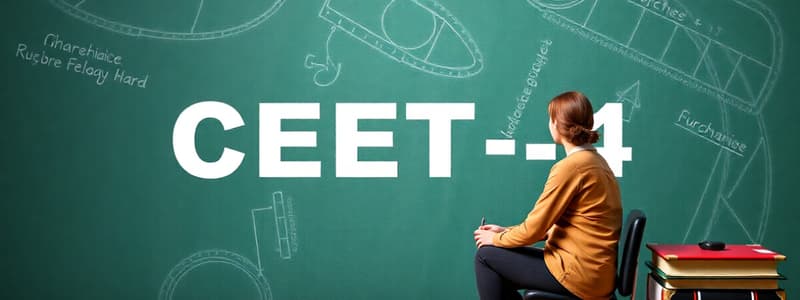Podcast
Questions and Answers
Match the following words with their appropriate definitions:
Match the following words with their appropriate definitions:
Ubiquitous = Present, appearing, or found everywhere. Mundane = Lacking interest or excitement; dull. Ephemeral = Lasting for a very short time. Esoteric = Understood by only a small number of people with a specialized knowledge.
Match the prefixes with their meanings:
Match the prefixes with their meanings:
Pre- = Before Re- = Again Un- = Not Dis- = Opposite
Match the suffixes with the part of speech they typically form:
Match the suffixes with the part of speech they typically form:
-tion = Noun -able = Adjective -ly = Adverb -ness = Noun
Match the root words to their meanings:
Match the root words to their meanings:
Match the following sentence types with their primary function:
Match the following sentence types with their primary function:
Match the types of clauses with their functions in a sentence:
Match the types of clauses with their functions in a sentence:
Match the verb tenses with their corresponding time frames:
Match the verb tenses with their corresponding time frames:
Match the types of pronouns with their uses:
Match the types of pronouns with their uses:
Match the sentence elements with what they modify:
Match the sentence elements with what they modify:
Match the functions with the correct type of conjunction:
Match the functions with the correct type of conjunction:
Match each vocabulary word with its synonym:
Match each vocabulary word with its synonym:
Match the grammatical structures with their typical use:
Match the grammatical structures with their typical use:
Match the examples with their rhetorical devices.
Match the examples with their rhetorical devices.
Match the idioms with their meaning:
Match the idioms with their meaning:
Match the phrasal verbs with their meaning:
Match the phrasal verbs with their meaning:
Match the adverbial clauses with the relationship they express:
Match the adverbial clauses with the relationship they express:
Match the following irregular verbs with their past participle forms:
Match the following irregular verbs with their past participle forms:
Match the correlative conjunctions with a sentence that properly uses them:
Match the correlative conjunctions with a sentence that properly uses them:
Match the words with whether they are countable or noncountable nouns:
Match the words with whether they are countable or noncountable nouns:
Match the following academic vocabulary with their definitions:
Match the following academic vocabulary with their definitions:
Flashcards
词根词缀记忆法 (Root and affix memorization)
词根词缀记忆法 (Root and affix memorization)
A method of memorizing vocabulary by breaking words down into their constituent parts to understand their meaning.
联想记忆法 (Association memorization)
联想记忆法 (Association memorization)
A vocabulary memorization technique that create associations between words and images, sounds, or scenarios to boost memory.
语境记忆法 (Contextual memorization)
语境记忆法 (Contextual memorization)
Learning new words through reading and writing and understanding their context and usage.
词法 (Morphology)
词法 (Morphology)
Signup and view all the flashcards
句法 (Syntax)
句法 (Syntax)
Signup and view all the flashcards
主谓结构 (Subject-Predicate Structure)
主谓结构 (Subject-Predicate Structure)
Signup and view all the flashcards
主谓宾结构 (Subject-Predicate-Object Structure)
主谓宾结构 (Subject-Predicate-Object Structure)
Signup and view all the flashcards
主谓宾宾结构 (Subject-Predicate-Object-Object Structure)
主谓宾宾结构 (Subject-Predicate-Object-Object Structure)
Signup and view all the flashcards
主谓宾补结构 (Subject-Predicate-Object-Complement Structure)
主谓宾补结构 (Subject-Predicate-Object-Complement Structure)
Signup and view all the flashcards
主系表结构 (Subject-Linking Verb-Predicate Structure)
主系表结构 (Subject-Linking Verb-Predicate Structure)
Signup and view all the flashcards
简单句 (Simple Sentence)
简单句 (Simple Sentence)
Signup and view all the flashcards
复合句 (Complex Sentence)
复合句 (Complex Sentence)
Signup and view all the flashcards
名词性从句 (Noun Clause)
名词性从句 (Noun Clause)
Signup and view all the flashcards
定语从句 (Attributive Clause)
定语从句 (Attributive Clause)
Signup and view all the flashcards
状语从句 (Adverbial Clause)
状语从句 (Adverbial Clause)
Signup and view all the flashcards
非谓语动词 (Non-finite Verb)
非谓语动词 (Non-finite Verb)
Signup and view all the flashcards
被动语态 (Passive Voice)
被动语态 (Passive Voice)
Signup and view all the flashcards
虚拟语气 (Subjunctive Mood)
虚拟语气 (Subjunctive Mood)
Signup and view all the flashcards
倒装句 (Inverted Sentence)
倒装句 (Inverted Sentence)
Signup and view all the flashcards
一致 (Agreement/Concord)
一致 (Agreement/Concord)
Signup and view all the flashcards
Study Notes
- 大学英语四级考试是对大学生英语能力的综合测评,词汇和语法是考试的基础。
词汇
- 词汇是英语学习的基础,四级考试要求掌握一定数量的词汇。
- 词汇记忆方法多样,包括词根词缀记忆法、联想记忆法、语境记忆法等。
- 词根词缀记忆法通过分析单词的构成,理解词义,扩大词汇量。
- 联想记忆法通过将单词与图像、声音或情境联系起来,增强记忆效果。
- 语境记忆法通过在阅读和写作中学习单词,理解单词的用法和含义。
- 常见词根包括:-port- (携带), -vis/vid- (看), -spect- (看), -form- (形状), -struct- (建造) 等。
- 常见前缀包括:un- (不), dis- (否定), re- (重新), in-/im- (不/向内), pre- (之前) 等。
- 常见后缀包括:-tion/-sion (名词), -able/-ible (形容词), -ly (副词), -ment (名词), -ness (名词) 等。
- 词汇学习需要注意同义词、反义词和近义词的辨析。
- 考试中常见的词汇题型包括:词义辨析、近义词替换、词汇搭配等。
- 备考过程中,应结合真题和模拟题,进行有针对性的词汇复习。
- 除了教材词汇外,还应适当补充一些高频词汇和常用短语。
- 利用APP和在线资源,可以随时随地进行词汇学习。
- 制定合理的学习计划,每天坚持一定的词汇学习量。
- 掌握词汇的用法,包括词性、搭配和常见短语。
- 注意区分形近词和同音词,避免混淆。
- 定期复习已学词汇,巩固记忆效果。
语法
- 语法是英语表达的规则,四级考试要求掌握基本的语法知识。
- 英语语法主要包括:词法和句法。
- 词法研究单词的构成、分类和变化,包括名词、动词、形容词、副词、代词、介词、连词、数词和感叹词。
- 名词有单数和复数形式,可数和不可数之分。
- 动词有时态、语态和语气等变化。
- 形容词用来修饰名词,有比较级和最高级形式。
- 副词用来修饰动词、形容词或其他副词。
- 代词用来代替名词,包括人称代词、指示代词、物主代词、反身代词、疑问代词和关系代词。
- 介词用来表示名词或代词与句子中其他成分的关系。
- 连词用来连接词语、短语或句子。
- 句法研究句子的结构和成分,包括主语、谓语、宾语、定语、状语、补语等。
- 英语的基本句型包括:主谓结构、主谓宾结构、主谓宾宾结构、主谓宾补结构、主系表结构。
- 简单句只有一个主谓结构,复合句包含一个或多个从句。
- 从句包括:名词性从句、定语从句和状语从句。
- 名词性从句充当句子中的名词成分,如主语、宾语、表语和同位语。
- 定语从句修饰名词或代词,由关系代词或关系副词引导。
- 状语从句修饰动词、形容词、副词或整个句子,表示时间、地点、原因、条件、让步、目的、结果等。
- 英语中有五种基本时态:一般现在时、一般过去时、一般将来时、现在进行时和过去进行时。
- 还有现在完成时、过去完成时、将来进行时和将来完成时等。
- 被动语态表示主语是被动承受动作的对象。
- 虚拟语气用来表示假设、愿望、建议等。
- 倒装句是将句子中的某些成分放在主语之前,以强调或表达特殊的语用意义。
- 一致是指主语和谓语在人称和数上保持一致。
- 非谓语动词包括:不定式、动名词和分词。
- 考试中常见的语法题型包括:单项选择、完形填空、语法改错等。
- 备考过程中,应系统学习语法知识,并通过练习巩固。
- 重点掌握常见语法现象和易错点。
- 注意分析句子结构,理解句子含义。
- 提高语法的运用能力,准确表达自己的思想。
- 结合真题和模拟题,进行有针对性的语法复习。
- 制定合理的学习计划,每天坚持一定的语法学习量。
- 掌握各种从句的用法,包括引导词和连接词。
- 注意时态和语态的运用,避免混淆。
- 定期复习已学语法知识,巩固记忆效果。
- 理解各种非谓语动词的用法,包括不定式、动名词和分词。
Studying That Suits You
Use AI to generate personalized quizzes and flashcards to suit your learning preferences.




